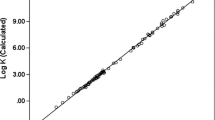Abstract
A versatile method for measuring the partition coefficients of volatile analytes with an aqueous pseudophase using headspace gas chromatography is reported. A “three-phase” model accounts for all equilibria present in the system, including the partitioning of the analyte in the gas and aqueous phases to the pseudophase. This method is applicable to a wide variety of volatile analytes and aqueous pseudophases, providing that sufficient pseudophase may be used to reduce the analyte partial pressure. Generally, the method offers good reproducibility and high sensitivity. The associations of five volatile analytes (hydrogen sulfide, methanethiol, dimethyl sulfide, dichloromethane, and ethyl ether) with various cyclodextrins were examined. All analytes were found to partition preferentially to the cyclodextrin pseudophase compared to the aqueous phase. In addition, several analyte–cyclodextrin combinations formed insoluble complexes in solution that enhanced the extraction of the analyte from the gas and aqueous phases. Derivatization of the cyclodextrins generally decreased the extent of analyte–cyclodextrin interaction.


Similar content being viewed by others
References
Christian SD, Scamehorn JF (eds) (1995) Solubilization in surfactant aggregates. In: Surfactant science series, vol 55. Marcel Dekker, New York
Miller CA, Qutubuddin S (1986) Enhanced oil recovery using microemulsions. In: Elicke HF, Prafitt G (eds) Interfacial phenomenon in nonaqueous media. Marcel Dekker, New York
Vane LM, Giroux EL (2000) J Chem Eng Data 45:38–47
Kashiyama N, Boving TB (2004) Environ Sci Technol 38(16):4439–4444
Winters LJ, Grunwald EJ (1965) Am Chem Soc 87(20):4608–4611
Kant A, Linforth RST, Hort J, Taylor AJ (2004) J Agric Food Chem 52:2028–2035
Goubet I, Dahout C, Sémon E, Guichard E, Le Quéré JL, Voilley A (2001) J Agric Food Chem 49:5916–5922
Reineccius TA, Reineccius GA, Peppard TL (2005) J Agric Food Chem 53(2):388–392
Qu Q, Tucker E, Christian SD (2003) J Incl Phenom Macrocycl Chem 45(1–2):83–89
Uekama K, Irie T (1996) Pharmaceutical use of cyclodextrins in various drug formulations. In: Cyclodextrins (Comprehensive supramolecular chemistry, vol 3). Elsevier, New York
Ueda H, Nagai T (1996) Aspects of drug formulation with cyclodextrins. In: Cyclodextrins (Comprehensive supramolecular chemistry, vol 3). Elsevier, New York
Armspach D, Gattuso G, Königer R, Stoddart JF (1999) Cyclodextrins. In: Bioorganic chemistry: carbohydrates. Oxford University Press, New York
Hai M, Han B (2003) J Colloid Interf Sci 267:173–177
Hussam A, Basu SC, Hixon M, Olumee Z (1995) Anal Chem 67:1459–1464
Armstrong DW, Nome F (1981) Anal Chem 53:1662–1666
Armstrong DW, Stine GY (1983) J Am Chem Soc 105:2962–2964
Janini GM, Attari SA (1983) Anal Chem 55:659–661
Menges RA, Armstrong DW (1991) Anal Chim Acta 255:157–162
Rundlett KL, Armstrong DW (1995) Anal Chem 34:2088–2095
Armstrong DW (1985) Sep Purif Methods 14:213–304
Nishi H, Fukuyama T, Terabe S (1991) J Chromatogr 553:503–516
Conder JR, Young CL (1979) Physicochemical measurements by gas chromatography. Wiley, New York
Laub RJ, Pecsok RL (1978) Physicochemical applications of gas chromatography. Wiley, New York
Loesche WJ, Kazor C (2002) Periodontology 2000 28:256–279
Sanz M, Roldán S, Herrera D (2001) J Contemp Dent Pract 2:1–13
Smet E, Van Langenhove H (1998) Biodegredation 9:273–284
Carroll JJ, Mather AE (1989) Geochim Cosmochim Acta 53:1163–1170
Hine J, Weimar RD Jr (1965) J Am Chem Soc 87:3387–3396
Dacey JWH, Wakeham SG, Howes BL (1984) Geophys Res Lett 11:991–994
Wright DA, Sandler SI, DeVoll D (1992) Environ Sci Technol 26:1828–1831
Nielson F, Olson E, Fredenslund A (1994) Environ Sci Technol 28:2133–2138
Szejtli J (1996) Chemistry, physical and biological properties of cyclodextrins. In: Cyclodextrins (Comprehensive supramolecular chemistry, vol 3). Elsevier, New York
Sanemasa I, Wu J, Toda K (1997) Bull Chem Soc Jpn 70:365–369
Liu Y, You C (2001) J Phys Org Chem 14:11–16
Saenger W, Steiner T (1998) Acta Crystallogr A54:798–805
Szejtli J (1982) Cyclodextrins and their inclusion complexes. Akademai Kiado, Budapest
Armstrong DW, Nome F, Spino LA, Golden TD (1986) J Am Chem Soc 108:1418–1421
Acknowledgements
Thanks are extended to GlaxoSmithKline for their generous funding and support for this research.
Author information
Authors and Affiliations
Corresponding author
Rights and permissions
About this article
Cite this article
Lantz, A.W., Wetterer, S.M. & Armstrong, D.W. Use of the three-phase model and headspace analysis for the facile determination of all partition/association constants for highly volatile solute–cyclodextrin–water systems. Anal Bioanal Chem 383, 160–166 (2005). https://doi.org/10.1007/s00216-005-0030-9
Received:
Revised:
Accepted:
Published:
Issue Date:
DOI: https://doi.org/10.1007/s00216-005-0030-9




